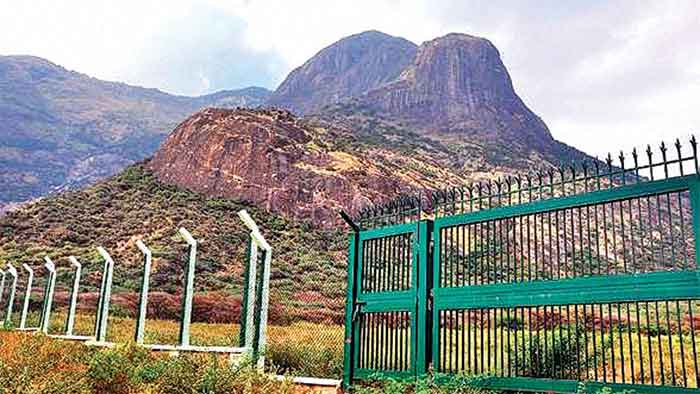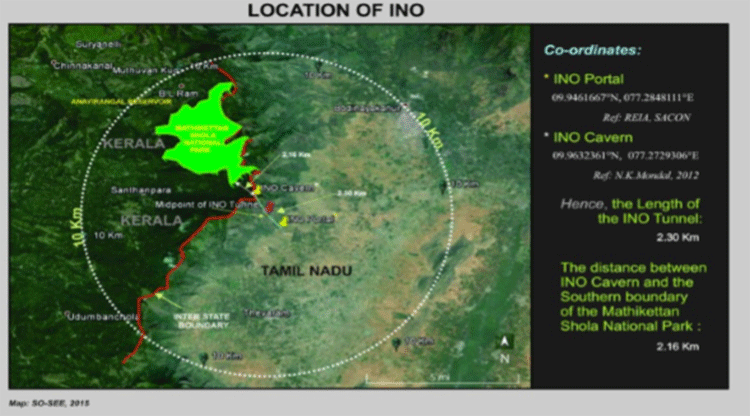
Tamil Nadu has reportedly made clear to the Supreme Court that it does not want the Indian Neutrino Observatory (INO) to be set up in a sensitive ecological zone in the Western Ghats at great cost to wildlife, biodiversity, and by ignoring the local opposition and public agitations to the project.
Neutrinos are esoteric
Neutrinos, first postulated in 1930 by Wolfgang Pauli, are naturally occurring elementary particles without electric charge, emanating mostly from the Sun and traveling almost at the speed of light. The study of neutrinos is expected to reveal the origin of the Universe and form the basis of esoteric studies.
Government had proposed constructing an INO 1.3-km underground in the Singara-Masinagudi area of Tamil Nadu’s Niligiris District, in 2005. Following sustained public resistance, government dropped the Singara-Masinagudi site and decided to construct the INO in Tamil Nadu’s Theni District.
The reasons for which the Singara-Masinagudi site was dropped are applicable to the present Theni District site for INO, and deserve to be made known.
Engineering and environment
The INO project requires construction of large caverns 1.2-km underground, with many kilometres length of approach, connecting and safety tunnels and roads. It will involve rock-blasting and use of large earthmoving machines.
One estimate of the volume of rock and earth spoil to be excavated is around 225,000-cum (625,000 tons). This will have to be transported away from the underground site by convoys of dumper and tipper trucks. The spoil will be disposed as landfill in designated low-lying areas, change natural rainwater drainage patterns, and irreversibly desertify large areas of land whether inside forest area or outside.
Many thousand tons of construction material like bitumen, cement, steel, stone aggregate and sand will be imported for constructing approach roads and underground structures. This will require land acquisition and forest clearance as necessary, to store machinery and construction materials to provide concrete for construction and bitumen for roads. The accompanying noise, smoke and dust over the years taken for construction, will irreversibly impact human and animal life and green cover. The industrial/construction activity connected with the INO construction will involve loss of native vegetation and entire ecosystems in the area.
A 50-kilotonne magnet and other scientific apparatus installed underground, will require dedicated power generation, and power transmission lines, involving further environmental degradation.
Regardless of assurances given by project proponents, only the environmentally-illiterate or scientifically-challenged will deny that there will be enormous irreversible environmental and ecological damage caused by the INO project. An environment impact assessment (EIA) may suggest measures to minimize or mitigate damage, but cannot legitimately address the permanent destruction/disruption of ecosystems, and species extinction.
Deforestation in the Western Ghats region will seriously compromise subsoil water-retention capacity, and result in streams and rivulets in the region drying up. This will reduce flow in already depleting downstream rivers, upon which huge populations in Tamil Nadu depend for life and livelihood.
Hard questions
There is a conflict between the expected scientific and intellectual gains of the INO project, and the direct and immediate damage to the environment and ecology, and more delayed direct and indirect ill-effects, especially on weaker sections of society. Hence there is need to ask some hard questions:
- How does using INO for investigations into the origin of the universe help in solving problems of food crisis and poverty and, in the context of impending climate change, the greater problems of water and food crises and mass migration of people due to desertification of the sub-continent?
- Was a cost-benefit analysis for the INO project carried out, and if so, what are considered as social benefits?
- It is facile to argue that cutting-edge scientific research cannot be stopped, because neutrino research is part of the human quest for knowledge concerning particle physics, cosmology and the origin of the Universe. Indeed, justifying INO, Dr.D.Indumathi of the Institute of Mathematical Sciences, had stated: “It is still not known whether neutrinos are Majorana or Dirac”. How important is it for the non-scientific community to get excited by such esoteric riddles, which even most of the scientific community would not begin to understand?
Science and society
Scientific research is based on industry which provides the hardware, and is a capital-intensive guzzler of electric power, from the manufacturing and fabrication stage to the installation and operation stage. There are kinds of science that do not even remotely serve the basic needs of society. It is not that money cannot be found to finance esoteric science projects, but that such expenditures do not contribute to here-and-now development for People.
A scientist, a doctor, an engineer, may understand development differently from say, a small farmer, factory worker or daily wager. So we may seek the purpose of development, which the UN Cocoyoc Declaration, 1974, provides: “Our first concern is to redefine the whole purpose of development. This should not be to develop things but to develop man. Human beings have basic needs: food, shelter, clothing, health, education. Any process of growth that does not lead to their fulfillment – or, even worse, disrupts them – is a travesty of the idea of development”.
INO is meant to advance scientific knowledge. It will contribute to economic growth by raising the GDP, as huge sums are spent on its construction, operation and maintenance. A person who understands development in terms of increasing economic activity and rate of GDP growth – like our economists – would support the project. However, the INO fails to even remotely address any of the basic needs of people.
INO will have ill-effects on the environment, which holistically includes all people, wildlife and vegetation (ecosystems). Worse, it disrupts People’s legitimate basic needs and mocks at the idea of people-centered development, because it effectively snatches bread from hungry people. To be fair, this does not apply only to the INO project, although it is the proximate cause for taking up the issue of the kind of science which is appropriate or ethically acceptable for people-centered development.
End note
The INO project offers no advantages to people or society in the future, but does involve immediate and irretrievable social and environmental/ecological costs. Mature thinking recognizes, understands and accepts inequalities in society. However, if development is to be of and for people, the ethics of political leadership demands that the actions of people in positions of power should be for reducing social and economic inequality.
The current governance system uses the economic-political power structure to centralize wealth accumulation. It accentuates economic inequalities. Development planned in the hope and expectation of economic benefits in the future to one section of people, by payment of here-and-now costs to a different set of people who are already lower on the socio-economic ladder, is a plan for institutionalized social injustice.
The INO project may provide intellectual-professional benefits to a minuscule minority, but it offers no larger social or economic benefits. It can only be termed as socially inappropriate and ecologically and environmentally disastrous. Ethical and moral questions should take precedence over economic or intellectual compulsions. Therefore, from a holistic perspective, the INO project deserves to be dropped.
References
- “Tamil Nadu says ‘no’ in Supreme Court to neutrino observatory project“; <https://www.thehindu.com/news/national/tn-says-no-in-supreme-court-to-neutrino-observatory-project/article65059219.ece>; The Hindu; February 18, 2022.
- “India-based Neutrino Observatory (INO)”; <http://www.imsc.res.in/~ino/>.
- “Searching for Neutrinos in Mudumalai”; <http://www.vijayvaani.com/ArticleDisplay.aspx?aid=81>; Vijayvaani.com; August 24, 2008.
Maj Gen S.G.Vombatkere, VSM (Retd), holds a PhD degree in Civil Structural Engineering from I.I.T., Madras. His current areas of interest are development and strategy. <[email protected]>











































